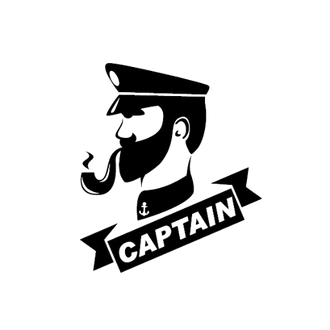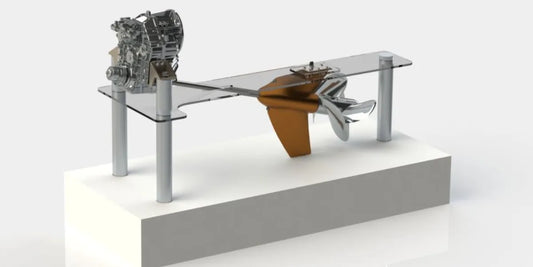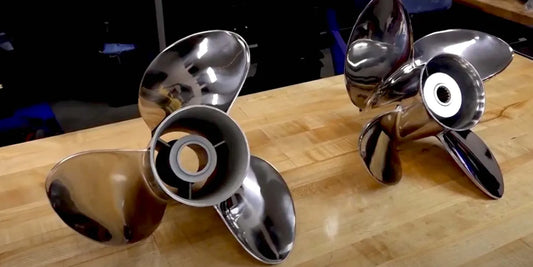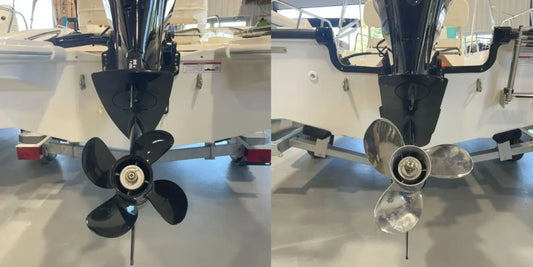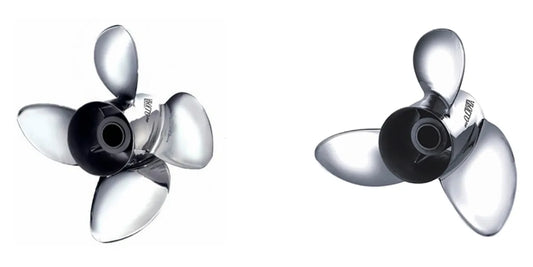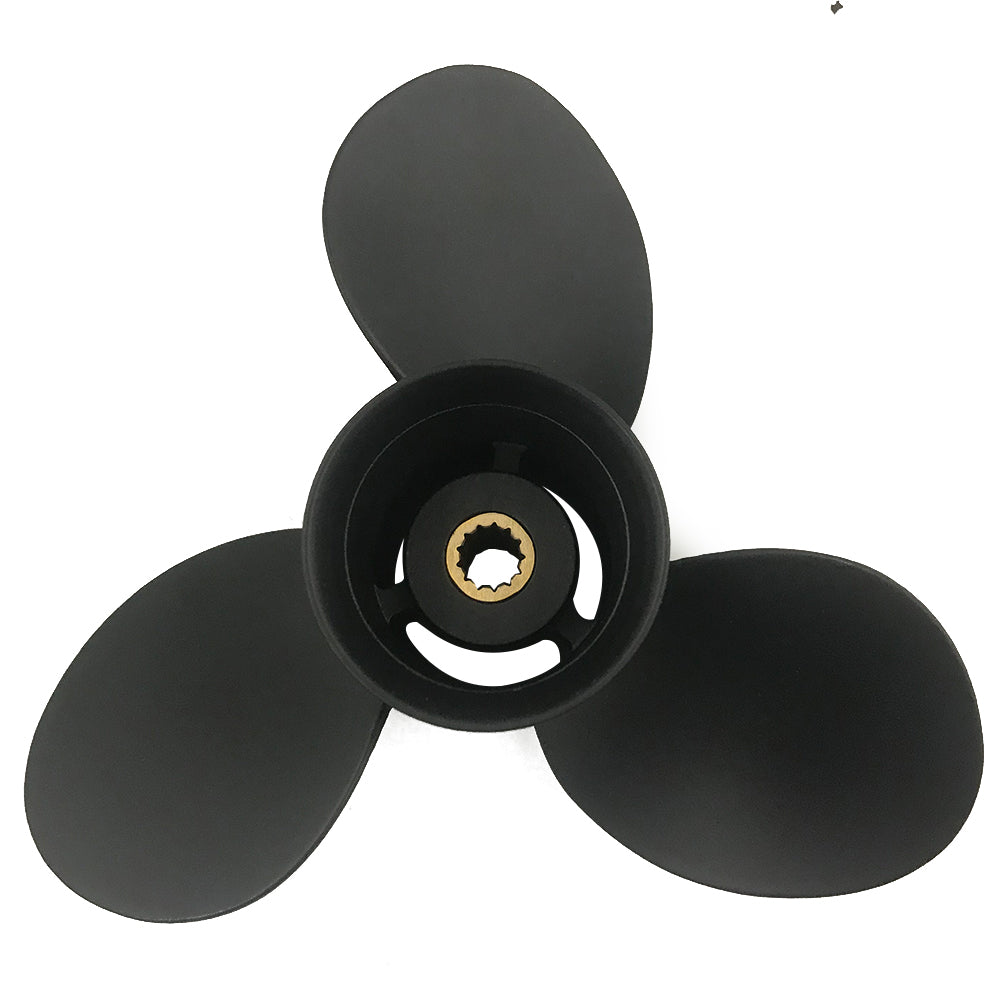There are several factors that affect a boat's performance, and the choice of propeller is one of the most crucial. One of the key issues that faces many boat users is the choice between a three-bladed and a four-bladed propeller. This may appear trivial, but such a decision is of great consequence. It affects the stability and may adversely affect the speed, fuel efficiency, and other service requirements of the boat. One would also be right in saying that choosing a blade number is out of other unconscionable factors. There is no greater distinction between 3-blade and 4-blade propellers than this one, and we will provide you with the information that will help you make an informed decision, based on the needs of your boat, including its performance and level of utilization. It does not matter what kind of boat person you are, a recreational or an extreme boater. One of the most essential elements: understanding exactly these types of propellers. Focus on this even more as we dig deeper, pointing out the trade-offs and the trade-offs among the trade-offs when it comes to choosing the right propeller for your watercraft.
Understanding Propeller Basics

What is a Boat Propeller?
A boat propeller refers to a necessary tool that converts the internal combustion engine’s energy, more specifically its rotating energy, into motion, which pushes the watercraft forward on water. It is essentially made of sturdy materials due to these blades’ resilience limitations and includes a central hub with blades around it. These blades are configured to rotate in such a way that they create a pressure difference, which essentially causes the water to flow in the opposite direction and propel the vessel forward. For a propeller to work effectively, it requires several basic dimensions, including diameter, pitch, screwing, and the shape of the blade. The most common of them all, having the lower pitch, can accelerate well but has a low top speed, whereas a higher pitch allows high-speed but drops power off the bottom. These constructs will have a significant impact on the efficiency and productivity of the propeller, which necessitates the selection of one that best suits the existing engine power and the intended use of the boat.
Functions of Propellers
Boats are explained as objects that experience motion with an engine that drives them independently. Every component of a ship is intentionally designed and made to work seamlessly and conform to the laws of math and physics, and we can probably all agree. This section will concern itself with how boats can move on their own accord, that is, without any outside assistance. Boat propulsion and associated terminology are common to most mariners. And like we all love reading, let’s take a deeper dive into that. When researching the topic of why boats float in water and how ships move on water, you may come across such questions as - what is a propeller, how does a propeller work, how is a propeller attached to the engine, what does a propeller do, what is a propeller made out of, what role does a propeller play in a boat, how many propellers does a boat need, what is an articulated or split blade propeller, are there other alternative propulsion technologies, etc. Aren’t you glad you won’t merely pass time but learn a great deal as you work on your boat, refining knowledge worthy of essay money!
Yields of a propellor depends on more than just how it is physically marketed but as well with the setting it operates. For instance, the formation of bubbles on the propeller due to an inverted blade pressure environment, a phenomenon known as cavitation, will significantly reduce the propeller’s efficiency and potentially damage the material over time. Hence, in turn, containing the problem by using the appropriate material, such as aluminum, which provides a balance between price and lightweight performance, or stainless steel, which is more concerned with lasting quality rather than cost, makes more sense. They also make it possible to eliminate such risks while enhancing the standard of performance, regarding the price and the FORWARD THRUST allowed. In addition to that, abstract variables such as revolution per minute (RPM), the shape of the boat's bottom, and the amount of cargo it carries become fundamental in maximizing resource utilization.
Other advances in propeller technology, as well as those mentioned earlier, include the use of variable pitch propellers and computerized design and modeling techniques. The use of variable pitch changes the inclination of each fin the moment the machine is activated, ensuring it remains within the required limits at different speeds and conditions. Such advances, together with the ability to understand the data, ensure that very minimal amounts of fuel are used, the level of performance is awe-inspiring, and perfect control of the propeller is achieved.
The significance of propeller design.
Marine engineering insiders identify propeller design as one of the most important disciplines that significantly impact the aspects of a vessel's performance, efficiency, and environmental sustainability. It is crucial when constructing the optimum propeller to ensure that the ship travels smoothly on water with the least resistance, as this will conversely correspond to savings in fuel and a reduction in pollution levels. The blade size, type, and plunge values are the most critical design parameters, which are usually optimized with careful consideration of thrust, power, and resistance to have reasonable operation even in a degraded marine environment. Aiding in the improvement of the propeller itself are new technologies that utilize lightweight materials, such as carbon fiber. They are considered rather frequently not only because of their superior ability to withstand damaging conditions but also because they help prolong operational life due to their rigorous resistance to foreign element erosion, rusting, and abrasion.
In addition to technological advancements, the use of new computational tools is also propelling improvements in design performance. One such ability is a better understanding of the definitive aspects of propeller dynamics, including hydrodynamics, performance, and the effect of optimization on design. Among technologies, CFD enables us to test simulation models before creating a prototype; therefore, it helps us understand operating conditions and variations in results due to other factors in any liquid system. Besides individual benefits, the use of these techniques addresses the international call of the entire sector, which is for green designs of water vehicles. This is facilitated by the higher design precision of propellers that mitigate cavitation effects and minimize diesel or petrol consumption. Given the above circumstances, adopting present-day trends in propeller construction is a necessity when building ships of today that must meet two requirements: efficient operation and environmental safety.
Comparing 3-Blade and 4-Blade Propellers

Design Variations in Three and Four-Blade Propellers
The primary distinction between 3-blade and 4-blade propellers is the construction of the propellers, which influences performance. A 3-blade has fewer blades than a 4-blade, hence making it capable of better speeds and less drag. It is such a design that one will seek above all for use in high-speed crafts and high-efficiency, low-power applications. Understandably, 4-blade propellers boast one more blade in addition to the other three, which translates into more uniform and smooth operation of the propeller under load, making the vessel more controllable, especially while running in rough seas or under some loaded conditions.
When viewed through a hydrodynamic lens, 3-bladed propellers exhibit the minimum area of contact per rotation of the blade from the hull, a characteristic that would generally decrease the causes of cavitation; however, this may come at the cost of generating sufficient forward thrust at lower speeds. On the other hand, we may consider the 4-bladed propellers, which typically possess a greater surface area, to be much better in terms of increasing thrust and control, especially during hard acceleration and when changing direction. This is why they have a preference for certain types of vessels that require greater stability, such as those of a coastal nature, including fishing boats, tugboats, or boats used in rough sea conditions.
According to the data on efficiency, three-blade propellers are more likely to achieve optimal fuel efficiency at high speeds. In contrast, four-blade propellers outshine them in applications that require superior survivability and variable speed operation. Deciding upon either of the above designs also involves calculating the parameters specific to the particular vessel, including its weights, loads, and the different water states resulting from these factors, as well as determining the appropriate propeller for operation and spinning characteristics.
Performance Characteristics of 3-Blade Propellers
Propellers with three blades can offer more opportunities and effectiveness, especially in terms of conserving speed and fuel. These propellers often have lower resistance compared to four-blade propellers. As a result, any vessel using the former configuration could be pushed through the water with greater force, requiring the same amount of energy expended. Moreover, they have a reduced weight and lack complications associated with arrangements, thus offering high performance and are therefore preferred for cruise boats, pleasure boats, and racing boats.
They are furthermore preferable for use in open water, where their design – with minimal interfaces between hydrofoils and the surroundings – is particularly advantageous or optimized. There is evidence from some reviews that the ideal number of blades that causes the least drag is either three or four. It also means that the vessels have expended less energy and utilized their engines more efficiently when using the three-blade propeller, hence making it a fuel-saving propeller. Additionally, this innovation ensures a smooth and vibration-free operation of the boat, reducing wear on other parts along the way.
Moreover, there is one argument concerning functions of 3-blade generators as well. Due to difficulties and problems with the 3-blade propellers at high loads or in cross seas, when it is necessary to increase the propeller’s thrust and power, we can’t ignore those cases. These qualities outline the necessity of a rational choice of propellers in the context of the vessel’s operational usage, ensuring an optimal tradeoff among the maximum speed that a hull form can achieve, efficiency, and service requirements.
Qualitative Characteristics of 4-Blade Propellers?
4-blade propellers are also regarded as those that can provide more power without cavitation, while being more resistant to vibrations; hence, they are used in applications requiring more effective manipulation and increased control. The more detailed design features related to such propellers will be in terms of blade areas, which are larger compared to the initial argument blades. They are capable of displacing more water to provide additional propulsion, particularly in worst-case scenarios when heavy seas are assumed. This characteristic is beneficial for some of the larger boats available, such as yachts, commercial vessels, or offshore craft that are driven in and where speed is reduced or where the boat's direction must be constantly changed during a course.
The design of 4-blade propellers also warrants mention, thanks to the anti-cavitation properties they possess, particularly when operating at low speeds. The reduction in cavitation results in decreased air emissions, and less energy is consumed, as the phenomenon of cavitation aligns with the propeller's revolution speed. This makes fuel savings an exciting prospect for transportation, especially on voyages where silence is required. The surface on the blade creates an increase in water blocked due to the added blade, which improves efficiency while going astern and allows better control in delicate mooring conditions, for example.
Although 4-blade wheels enclose less water and, as a result, lose a little more speed to them than 3-blade wheels, these propellers, due to their thickness, hail and ability to operate in abnormal conditions, can solve problems with structures that work smoothly and without surprises. Selecting the right propeller is a matter of performance trade-offs, such as enabling high speeds at the expense of handling, and ensuring it serves the purpose and meets risk limits within the ship's environment.
Advantages of 3-Blade vs 4-Blade Propellers

Associative and temporal constraints of 3-blade rotors
3-blade propellers are typically highly speed-efficient in terms of both fuel consumption and speed, and therefore are recommended as best for speed-specific purposes. These propellers can provide high levels of their main features such as speed, rate of fuel consumption and to that extent a battery in a hydrodynamic perspective as it entails the use of less blades in their design. This, in particular, results in less hydrodynamic drag for the vessel, and the low-energy state allows the engines to run at high torque and high speed without any RPM restrictions. Additionally, the more straightforward build results in a lower-weight propeller, which eliminates excess thrust while spinning the shaft. This, combined with the design, leads to faster and more agile turning in most cases. This particular type of squat, owing to not wasting water resistance and energy drainage, dictates that 3-blade propellers perform the best in the last two categories. This provision is most useful in leisure boats, sports boats, water taxis, ferries, and other high-speed crafts where efficient speed is prioritized over other aspects.
Third, conversationally charming, even this three-bladed propeller offers benefits in fuel efficiency at high speeds. The fewer blades, less drag, and less fuel consumption, and the engine also uses less fuel from the point of view of economy and operation – this is so! It also tackles fewer adverse effects on the surrounding environment. This has led many boat operators to select such a configuration when tasked with long-distance drives or operating in quiet waters, where higher structural strength to avoid vibrations and responsive sections are less critical. Focus on the fact that many of the other applications provided demonstrate the superior performance and speed of the system; these, in particular, come in handy very well. 3-blade propellers, although slightly tanked, can, by any chance, carry hefty loads or grapple with various weather conditions; most likely, they will not perform to the required standards. That is where the reduction of the thickness of the added blades would provide them with better muscles to at least enhance their speeds and to maintain the shaft straight. Thus, the process of selecting an appropriate propeller for any reason involves determining how the vessel is to be operated, which comes with a compromise between speed, efficiency, and the operational dependency of the equipment.
Stability and Control with 4-Blade Propellers
Four-bladed propellers were conventionally used in situations where excessive stability, precise control, and sufficient thrust force were required, particularly in severe environmental conditions. Increased safety in use, simplicity, and vibration reduction are benefits achieved with this type of design, which is particularly beneficial for activities such as towing, deep-sea and ocean fishing, and driving on rough waters. Such systems increase their effectiveness, particularly in terms of handling low speeds, while achieving high efficiency in situations such as reverse parking and driving. High efficiency of those propellers is also viewed from the perspective of their capability to function effectively in a sea with high roughness. Blade count raised efficiency even further. 4-blade propellers, however, do not achieve maximum speed relative to the 3-bladed examples it is mounted in.
Right Equipment For Your Need: Finding The Right Blade Count
Finding the most suitable number of blades for your propeller is determined by several things, including the kind of boat you have, what you intend to use it mainly for, and what you like as far as performance levels are concerned. For example, are you looking for increased speed and fuel efficiency from the 3-bladed propeller system for a pleasure boat or other recreational activities, such as water skiing? Conversely, a 4-blade has a mud grip and fewer vibrations, allowing for smooth bends through the involvement of fluid mechanics and minimal damage. Therefore, in boat as fishing or sufficing and landing tackle other than in the which water is instead settling waves and consequently height and depth of water are problem_undershot not offered intended for river waters bow thruster or beyond the paint such as the windlass and the anchor winches in suitable for navigation for ships with excessive waves also known slow moving cutter boat continued north/south on outside remaining inside sewers under the road bridge.
Recent information indicates that 4-bladed propellers are currently the most common type in use, offering steady performance without generating excessive noise. On the other hand, there may be situations where a 3-blade propeller would be more ideal, especially at cruising speed or when the goal is to reduce drag. Furthermore, propeller designs have improved over the years in terms of materials used and manufacturing practices. These designs can have the same thrust regardless of the number of blades used. Moreover, these factors also enhance the life and functional benefits of the propeller. So, it is essential to know how these factors complement a boat, too.
Application Scenarios for 3-Blade and 4-Blade Props

Top 5 Applications of 3-Blade Propellers
A 3-blade propeller is a trim marine propeller that offers exceptional and rich performance, making it a suitable choice for many boaters. They are recommended explicitly for chasing top-end velocities, where they emerge as the most effective propellers on the market due to their reduced friction. The thinness of design is advantageous in propeller blades, as less thrust is needed to swing the blade through the water, thereby decreasing the bearing bolt diameters.
Another noteworthy advantage is that 3-blade props are often chosen to deliver an equal and sufficient thrust across different water surfaces while achieving rapid acceleration. As a result, such propellers are well-suited for tenders, cars, and any other boating alternative that involves a balance between speed and power to be maintained. Furthermore, they are highly valued because they easily accommodate a wide range of boat sizes and styles, and in most cases, function as they should.
When using 3-blade propellers, it is essential to select the appropriate pitch, diameter, and material for your specific boat model. This facilitates optimal utilization, especially in scenarios that require precision and high manoeuvrability. Their lightweight design also helps reduce rigging slack caused by the prime mover, leading to more efficient boat operation and preventing wear.
Best Uses for 4-Blade Propellers
4-blade sailboat’s propeller is a suitable choice if your primary concern is the quality of the boat’s performance under certain conditions. That’s because the sailing 4-blade propeller is very popular, and it is known to have reasonable control of performance under any environmental conditions. One of the key advantages of the sailing 4-blade is that it allows for higher lift compared to the 3-blade, making it suitable for large, heavy-hulled boats such as catamarans and displacement boats used for towing operations, such as wakeboarding and skiing.
Additionally, a 4-blade propeller offers improved low-end torque, resulting in better controllability of the handlebars, more effortless acceleration, and improved steering at low speeds. This particular factor becomes more than imperative for a driver to maintain sufficient control in a confined area or when parallel to objects, such as other boats, during vehicular movements. Another advantage of such a type of propeller is that fewer or no vibrations and noise are allowed to emanate from the inboard back of the boat when these propellers are in use. Passengers will enjoy more deft and indeed calmer rides. Operational issues related to power plant operation are also a concern for owners interested in saving fuel. By contrast, if the four-blade propellers are employed on any boat, the consumption of marine fuel can still rise at higher rates by sustaining similar or even better cruising rates under varying loading and sea state conditions.
Factors to be taken into account while selecting
When selecting a propeller, I typically focus on the prevailing operational mode of the boat. This can encompass elements such as ocean depth, climate, and the nature of potential bodies of water, including rivers, lakes, seas, or oceans. It will be different if the depths are narrow… You will need a shallower propeller or one with less pitch to avoid hitting objects in the water. When driving the boat out to sea over a long distance, you may prefer a propeller that is both powerful and fast, rather than one that is just fast. The possibility of being in quiet or stormy weather also comes to mind, as this may impact the overall effectiveness of a propeller.
An alternative approach to this problem involves substituting a different cause. For instance, in an outsourcing process for window production, the type of glass used is causing the most significant concern, as it has evolved to glass with a lower threshold of brittleness. Therefore, when making windows, it is essential to consider both the size of the panes and the pliability of the glass used. If no changes are anticipated based on the window drawings, and steel for fixed lintels is available at economical conditions. If there is a need to fill such gaps in the steel, however, reinforcement charts should be readily available. Let me also mention that up-to-date analytical methods for calculating factors of safety are available, and this often requires revising the values of forces and deflections approved in construction calculations. If the planes are separated, one is allowed a degree of leeway in the strength of materials for fairly large loads and life cycles.
That said, my attention turns towards the engine specifications and how the propeller can serve its purpose. While the guidelines provided by the manufacturer regarding the diameter, pitch, and blade angle will be sufficient for many, I have additional parameters to consider. A practical step would be to try a few more propellers, if the circumstances allow, so that the boat's behavior is predictable under my typical usage. Opting for this method will enable me to satisfy the conflicting requirements of improving performance, reducing energy consumption in practical operation, and ensuring reliability, as the case may be.
Maintenance and Care for Your Propeller

Guideline Background to 3-Blade Propellers Maintenance
Proper Maintenance of your 3-blade propeller ensures optimal performance and can extend its lifespan. Well, it is in this regard that periodic checks are necessary, so that any form of damage, such as cracks, turns, or dents, or corrosion, is noticed in the course of inspection, so that something will be done before it is too late. Occasionally, clear the propeller of any particles, barnacles, or marine growth. A clean surface not only significantly reduces drag but also maintains the propeller's performance characteristics at their design standard levels.
Note and adjust the distance of the propeller’s leading edge to the objective and the pitch of the blades of the propeller from time to time. The distortion will produce vibrations, resulting in less traction, improved general performance of the machinery, and increased fuel efficiency in the rotor. Trimming and ensuring it does not entangle with fishing lines or seaweed are as important as placing the propeller shaft in a lubricated environment. In fact, such materials cause or force plates to wear prematurely, not to mention shafts to show leaks caused by the bearing lubricant.
One more essential precaution is to oil with great caution regularly—shielding the shaft with oil helps in avoiding any chances of rust formation and ensures that shaft rotations are as they are supposed to be. Furthermore, inspecting the hub for any tendency towards wear or sliding should also be done to prevent sudden faults. Provided that effective routine maintenance for the kinds of boats you operate is paired with the use of the corresponding technologies and instruments, the reliability and useful life of a 3-blade prop can slowly improve.
Preventative Services for 4-Blade Props
Periodic maintenance for 4-armed blade propellers is a move that I highly recommend to ensure there is no failure while in operation and no harm comes to the propeller. To initiate the regular maintenance process, I always take the time to conduct a thorough check on the blade for items such as cracks, scratches, and reeds. Big and with those serious bullies, such defects can thoroughly distort the balance of the vessel's propeller and reduce productivity, so at no given instance would I let these damages go unaddressed. Additionally, one must clear the space surrounding the prop to prevent the engine from holding, which can reduce efficiency. The procedure requires tools to remove the propeller fully as planned, without any fouling, in my opinion.
Just as important as changing the engine oil in my motor vehicle is ensuring the gearbox’s oil remains until its capacity is met, which is quite vital in the eyes of any person. I try to recreate the situation in which the vehicle is exposed, albeit gently, and trace oil leaks after which I replace or repair the affected sections. I always remember to apply silicone bead gasket sealer sparingly, as that is what helps minute screws withstand their promised work. I also remember to place a bit of rubber hose on each of the recessed oil plugs, because Nocona sandal spurs are overrated.
I also incline towards the hardware in the propeller setup of the four blades. Bolt workers shall lose their potential effectiveness if any change occurs in the 4-blade setup. It is beneficial to minimize effort and avoid the risk of omissions by delivering the mechanical system of the 4-blade propeller to the initialization phase in an entirely safe state. Yet, inspecting the structure and fixing the defects with proper actions is not enough for success in eliminating breakdowns and installing the 4-blade propeller; thus, this is why I keep a log of all inspections and repairs. In this way, claims that the 4-blade propeller lacked efficient output shall not miss the point.
Challenges and possible solutions
One common issue with 4-blade propellers that I have personally faced is cavitation, where air bubbles form around the propeller, leading to reduced efficiency and the potential for damage over time. To solve this, I always ensure that the right pitch and size of the propeller are fitted on the boat, which is suitable for the water. It is also essential to avoid algae or any other impurities from the surface of the propeller, as this can lead to cavitation. Also I ensure that every now and then I examine the propeller especially the blades for depletion or destruction, which helps me to detect any anomalies early and to eradicate this problem, for instance if any minor problems arise such as corrosion I would an expert to repair it..
A lot of helicopter maintenance reviews have concluded that a lot of these technical malfunctions are often the fault of the helicopter’s maintenance officials. As a result, to prevent this occurrence once more, experts have suggested the following precautions. Work hazards are stationed at various helicopter shelters at rice paddies and are properly operated and managed. If you don’t take the help of skilled and experienced authorities, a metal filler rod is used to work on the edges of the dent or the warped surface of the blade. Usually, adjusting a helicopter’s rotor blades is untroublesome, which is a totally different project every time a helicopter’s rotor screws need tightening. Not only are these proper safety procedures necessary, but one must also install a dirt collection system for rotor cooling fans.
There is a disadvantage to working out at sea, and it is the onset of corrosion. To prevent this from occurring, where necessary, I apply special protective agents on the propeller and always rinse it in fresh water upon finishing. Additionally, I regularly inspect and replace old or missing anodes to protect the propeller against the adverse effects of galvanic corrosion, ensuring it does not develop pitting. Finally, I want to emphasize that these efforts, including proper maintenance, are crucial in making the propeller last longer and work very effectively.
Reference Sources
-
3 Blade vs. 4 Blade Propeller - Michigan Wheel: Discusses the differences in pitch and performance between 3 Blade and 4-blade propellers.
-
3-Blade vs. 4-Blade Prop: What Are The Differences? - Reel Coquina Fishing: Explores cost-effectiveness, performance, and maintenance aspects of both prop types.
-
2-, 3- or 4-Blade Folding Propeller – What to Choose for Your Sailboat - Flexofold Blog: Offers insights into choosing the right propeller based on boat type and horsepower.
-
Choosing the Correct Boat Propeller - Crowley Marine: A technical guide on selecting the right propeller for optimal engine performance.
-
3 or 4 Blade Prop - Boat Talk Forum: A forum discussion comparing the efficiency and performance of 3-blade and 4-blade props.
Frequently Asked Questions (FAQs)
What is the real difference between the 3-blade and 4-blade propellers?
Basically, there are three or four blades in a propeller. Once you have one more blade than the other, the different characteristics of performance will follow. The 4-blade prop is more desirable at low speeds, as it is capable of providing the extra pulling power needed at those speeds, particularly for heavier boats or those requiring quick acceleration. A 3-blade prop is usually considered more efficient, theoretically giving you a little bit more speed and better mileage at higher speeds. The drag that the extra blade on the four-blade prop can induce is offset by the additional thrust and torque generated by the added blade, especially under adverse conditions. Choose accordingly based on your boat's hull and application.
Does the blade area influence a 3-blade prop's performance?
The blade area is quite crucial for determining propeller performance, especially when comparing a 3-blade propeller to a 4-blade one. Usually, a 3-blade propeller will have less blade area than a 4-blade prop, and this could lead to an increase in rpm and, in worthy cases, faster top-end speeds. Meanwhile, a large blade area could improve fuel mileage, and enhanced thrust at lower speeds could also increase fuel economy. Of course, when choosing the best prop for your boat, one must balance the blade area with the desired performance, including hole shot and planing speed.
Can a 4-blade propeller improve fuel economy?
4-blade propellers can, under some circumstances, enhance fuel economy. It may sound counterintuitive due to higher drag expected with the extra blade; however, a 4-blade prop generally provides a better thrust. This enables boats to plane at lower speeds. This means running a four-blade at a low throttle setting can give better gas mileage. As the higher torque from a 4-blade reduces the necessity to run at high RPM, keeping fuel consumption to a bare minimum, fuel efficiency is achieved. Nevertheless, these particular gains rely on the hull and engine characteristics of your boat.
What benefits does the use of a 4-blade prop confer at the low speeds?
Unlike 3- or 5-blade props that could lose a little pull at low speeds, 4-blade props are often preferred because they pull better at those speeds and accelerate more smoothly. With four blades, there is a slight increase in surface area that enhances the grip in the water, reducing cavitation when turning hard or accelerating hard. This is very useful for boats that require strong low-end torque, such as vessels meant for towing or carrying heavy loads. They also allow for slightly better planning speed, translating to improved performance in various conditions.
How does hull design affect the choice between a 3-blade and 4-blade prop?
The hull design itself will play the most significant role in determining whether a 3-blade or 4-blade prop is more suitable. 4-blade props provide increased thrust and stability for deep-V hulls, especially at slow speeds or during maneuvering. On the other hand, the 3-blade propeller usually allows flat-bottomed boats to reach higher speeds and achieve better overall efficiency in calm waters. Knowing your hull design and how it interacts with different props will take you a long way in determining which one is best for your needs.
What is the effect of pitch changes in 3-blade and 4-blade props?
The pitch of a propeller can change a boat's cruising efficiency through the water, an effect felt somewhat differently with 3 and 4-blade props. Both increases in pitch might allow a boat to go faster at the top end, but they would presumably slow down acceleration and damage fuel economy. Of course, when pitch is lowered, acceleration would be improved and hole shot optimized but at the cost of top-end performance. Pitching should take into consideration the intended use of the boat, engine specifications, and whether a 3-bladed or a 4-bladed prop would provide the best compromise between speed and efficiency at varying throttle settings.
